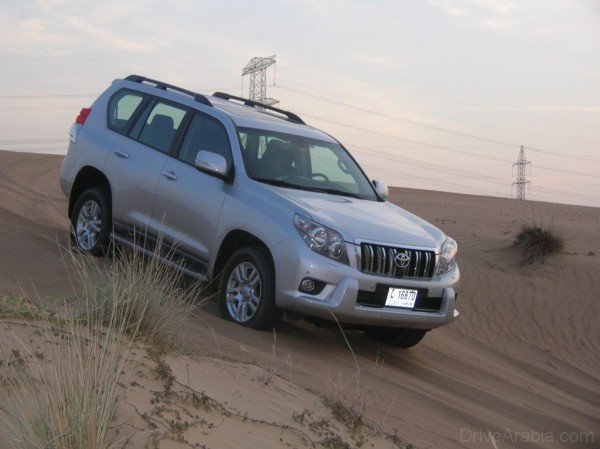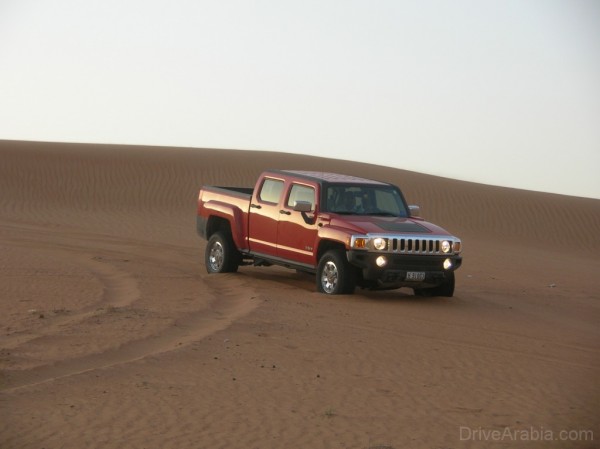Starting off with offroad driving on sand
Our region probably has the highest concentration of 4x4s on the planet. Given the immense popularity of offroad vehicles here, it is a shame that maybe 90% of them are never actually taken offroad, given that we live in the desert. However, offroad driving isn’t that hard once you know what you’re doing, and we’re here to tell just how to get started with your first desert adventure.
To start off, get an SUV with low-range gearing. It is generally indicated by a “4LO” setting on a lever or a knob somewhere in the car. We’d recommend something like a Toyota Prado, a Jeep Grand Cherokee or a Mitsubishi Pajero, or if you’re not bound by the constraints of family commuting, maybe even an FJ Cruiser or a Wrangler. Technically, it is possible to take all-wheel-drive crossovers such as the Toyota RAV4 or the Audi Q7 offroad, but with their lack of low-range, it’s not recommended to do so for anyone other than experts.
The first rule of exploring the dunes is to never go alone. Always have at least one other 4×4 in your convoy, preferably driven by an expert who can pick routes and get you out of trouble. And carry everything you think you may need, such as a strong tow rope and shackles to tie them on, a phone with charger, a shovel, a tyre-pressure gauge, a navigation system of any sort, and lots of water.

The basic theme with sand driving is to conserve your momentum. Since traction is seriously limited, trying to increase your speed can be difficult, and you do not want to lose any momentum, since you may not be able to regain it once you start slowing down unintentionally.
The first thing to do before driving on sand is to lower your tyre pressure all round. This is done to “float” better by increasing the size of your tyre “footprint,” which improves your traction exponentially. It also reduces the amount of strain on your vehicle’s structure, softening out the effect of bumps on the trail.
The optimum tyre pressure depends on your vehicle, the type of tyres fitted and the terrain, but a good starting point is to lower it to 15 psi. As you become more familiar with sand driving, you can intuitively alter this pressure as the terrain dictates, such as 17 psi for firmer wet sand or even 12 psi for overly loose sand.

Indeed, be sure to have a tyre pressure gauge, and keep track of petrol stations where you can re-inflate your tyres, or just buy your own air compressor.
As you lower tyre pressure, the tyre becomes more vulnerable to damage by stoking the sidewall or rolling the tyre off the rim. This isn’t an issue at 15 psi, but the lower the pressure, the higher the risk. But the gain in traction can be remarkable and may make the difference between becoming completely bogged down and simply driving away.
Speeds should be severely restricted at these low pressures if you have to drive on the road. To minimise tyre damage and safety risk on the road, it is important that these low pressures are only used on soft sand, and pressures should be immediately increased to the manufacturer-recommended tyre pressure once firmer terrain is reached.

When driving on sand, you should make an effort to follow in the tyre tracks of the vehicle in front as they have already compressed the sand to form a firmer surface than untouched ground. You can continue doing this as long as the ruts are not too deep. Never drive on vegetation and bushes.
Drive only as fast as you’re comfortable with. You should avoid rapid changes in speed when accelerating or braking. Braking on sand will cause a mound to build up in front of all wheels and possibly prevent your vehicle from moving off. Rapid acceleration simply digs the wheels in and can instead lead to a slower take-off speed.
Check that your tyres are pointing straight ahead when taking off to reduce the takeoff effort required. Move off as smoothly as possible with gear changes done at fairly high revs. Sand driving requires plenty of engine power to get your vehicle moving on the sand.
It is not necessary to use low-range gearing unless you are close to getting stuck. Low-range, available on most proper 4x4s, multiplies the amount of engine torque available and will provide that extra gear if you get stuck or have to climb a very steep tall dune. So make sure you read the manual on how to operate your low-range setting, as it varies depending on the model of your car. And always switch out of low-range once done.

When stopping on sand with a manual-gearbox car, depress the clutch and allow the vehicle to coast to a stop. This will minimise any sand build-up in front of the wheels. If the terrain permits, coast to a stop, rather than braking, with the vehicle pointing downhill as this will aid take-off. Avoid the soft sand at the base of most dunes and gullies when stopping.
When turning, make the turn as wide as possible to reduce the chance of bogging. Turning too sharp has a similar effect to applying the brakes. You may see others easily sliding around and having fun, but they’re probably more experienced than you at this point, so don’t copy them just yet.
Steep sand dunes should be traversed only straight up or down. If you drive even at a slight angle, the weight transfer is to the downhill-side wheels that tend to dig in and may lead to a potential rollover.

If you are moving straight down a steep dune, select first gear manually, even on your automatic gearbox if possible. If the back-end starts to slip sideways, it is best to accelerate slightly to try and straighten the vehicle. Never use the brake, as this will cause weight transfer to the front wheels and can increase the back-end’s sideways movement. However, at times you may find yourself rolling down too quickly, at which point, you can very lightly use the brakes while using the steering to stay straight in your path.
If you drive up a dune and think you cannot get to the top as you start bogging down, stop right away and don’t spin the tyres any further as you will only get stuck. Reverse down the dune in gear. Never coast down the dune and never attempt a U-turn.

To go over the peak of a dune, you have to judge the speed so that you don’t go too fast, leading to a jump and potential damage; and you don’t go too slow, leading to you getting beached at the top.
When you return, it is important to hose down your vehicle to remove all traces of sand. Pay special attention to areas like the mudguards where sand is sprayed around and tends to get trapped. Thoroughly hose underneath your vehicle as well, as there are many nooks and crannies where sand can also get trapped.
With this basic knowledge in mind, you should be able to get going on your first camping trip out in the desert. Always go with a more experienced friend who can lead you down the right trails, and as you keep going out there from time to time, you will get better and have more fun.







Comments
Mohammad Kamil
Finally!
tamer
Amateur tips actually
Lorry
That’s what the title infers, yes?
Faisal Khatib
You’d be surprised how many people don’t even know these basics.
Sting 316
This article is a job well done.
phoenix 212
After stopping the vehicle completely on sand, How to control the accelerator for moving without getting stuck?
vivek
The general rule is to apply the accelerator as gently as possible, and gradually build momentum once you start moving. As far as possible, ensure that you start moving in a rather straight line. If you feel that the vehicle is not moving and is bogging down, do not jam the accelerator pedal. Stop accelerating immediately, shift to reverse, and try accelerating out gently. If the vehicle still doesn’t budge, then check if the vehicle is equipped with a rear-diff lock. If it is, then engage it and retry. If not, then repeat the aforementioned steps after shifting to 4-low, only that this time, you will have to be even more gentler on the accelerator, and start off from the 2nd gear if possible (The ‘2nd start’ button can be used in Toyota Land Cruiser & Prado). If nothing works, then most probably you will need to be pulled out by another car. All this is assuming that your tyres are deflated to anywhere between 14-17 psi. If you have an air compressor with you, you may try temporarily deflating to 12-14 psi just to get unstuck.
As far as possible, ensure that you stop the vehicle in a place where its a downhill; even mild gradients will do. If not, then only stop in places where the sand appears to be firmer. That reduces the chances of getting stuck while accelerating from standstill.
host
the answer is “crawl” … you are a lizard and you must walk softly.
Sting316
Or get a FJ Cruiser.
Juan Barnard
Hi there
Im completely new to this 4×4 traveling. I was just wondering i read a few articles that High range 2nd gear is preferred for beach & Dune driving with tyre pressure at 14psi.
Would you mind sharing some light on this? I have a 2010 Fortuner D4D 4×4
Should i use high range or low range and will i have to activate my difflock?
Vivek
Hi Juan..
From my point of view what off-setting needs to be used greatly varies with the kind of vehicle you have, the engine spec, gear ratios etc. The only real way to know is to know your car, as in how it responds, and improvise accordingly..The basic rule is to spin your tyres as much less as possible while picking off from standstill, and then gradually gain momentum which you need to maintain.
D4D is Toyota’s turbodiesel engine which has plenty of torque in the low-end…In that case, normal beach and even moderate dune driving can be done in 4H itself, whch is the default selection..if the terrain is mild, even deflation of tyres may not be required, although it is always recommended that you do deflate especially if you are a beginner..and usually 16-18 psi is good enough in most situations..if you feel like the going getting tough, stop in an appropriate spot from whre you can resume driving later on without drama – like downwards on a slope or in a rather firm spot – and then you may lock your centre diff (Labelled as ‘4HL’ or just ‘HL’ I guess in the Fortuner) and start off in 2nd gear…if you feel like the vehicle is bogging down or has bogged down, you may stop and shift to low range (4LL or LL) and try moving off in 1st or 2nd gear spinning your tyres as slowly as possible…while stuck, engaging your rear diff will be a good idea, if you have one..and Once u r unstuck, disengage it and resume driving in 4HL..These are the basics.
Out in the wild, the situations you may encounter are endless.. just try to feel the response of the car in situation..if you are doubt, stop and step out to judge whats ahead; even walk it out of required..you will definitely make mistakes, but thats inevitable in becoming experienced. Good luck.